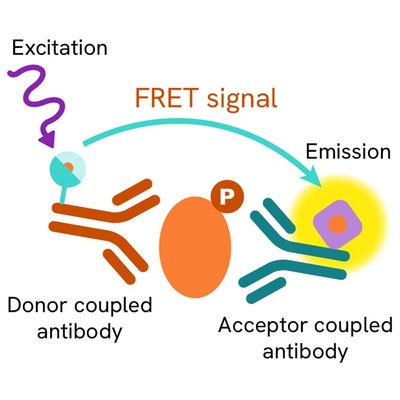

HTRF Human and Mouse Phospho-PDGFR-β (PDGF Receptor Beta) (Tyr751) Detection Kit, 500 Assay Points








| Feature | Specification |
|---|---|
| Application | Cell Signaling |
| Sample Volume | 16 µL |









Product information
Overview
The Phospho-PDGFRß (Tyr751) assay enables the quantitative detection of the modulation of the platelet-derived growth factor receptor beta, phosphorylated on Tyrosine 751. PDGFR beta signals and crosstalks via both the PI3K/AKT and the Ras/Raf MAPK pathways. This cell surface tyrosine kinase receptor ensures the binding of particular growth factors, which trigger the MAPK pathway leading to cell proliferation, cell differentiation and angiogenesis. When activated, PDGFRbeta forms a dimer and becomes phosphorylated, which means the phospho-PDGFRß assay is a valuable tool in oncology research.
How it works
Phospho-PDGFRß (Tyr751) assay principle
The Phospho-PDGFRß (Tyr751) assay measures PDGFRß when phosphorylated at Tyr751. Contrary to Western Blot, the assay is entirely plate-based and does not require gels, electrophoresis or transfer. The Phospho-PDGFRß (Tyr751) assay uses 2 labeled antibodies: one with a donor fluorophore, the other one with an acceptor.

The first antibody is selected for its specific binding to the phosphorylated motif on the protein, the second for its ability to recognize the protein independent of its phosphorylation state. Protein phosphorylation enables an immune-complex formation involving both labeled antibodies and which brings the donor fluorophore into close proximity to the acceptor, thereby generating a FRET signal. Its intensity is directly proportional to the concentration of phosphorylated protein present in the sample, and provides a means of assessing the proteins phosphorylation state under a no-wash assay format.
Phospho-PDGFRß (Tyr751) 2-plate assay protocol
The 2 plate protocol involves culturing cells in a 96-well plate before lysis then transferring lysates to a 384-well low volume detection plate before adding phospho-PDGFRß (Tyr751) HTRF detection reagents. This protocol enables the cells' viability and confluence to be monitored.

Phospho-PDGFRß (Tyr751) 1-plate assay protocol
Detection of Phosphorylated PDGFRß (Tyr751) with HTRF reagents can be performed in a single plate used for culturing, stimulation and lysis. No washing steps are required. This HTS designed protocol enables miniaturization while maintaining robust HTRF quality.

Assay validation
Hepatic LX2 stellate cells stimulated with PDGF
Human PDGF was used to induce phosphorylation of PDGFRß in human LX2 cells. LX2 cells, plated at different cell densities, were stimulated with various concentrations of human PDGF for 5 minutes. After a lysis step using 50 µL of supplemented lysis buffer, 16 µL of lysate were transferred into a 384-well low volume white microplate before the addition of 4 µL of the HTRF phospho-PDGFRß detection reagents. The HTRF signal was recorded after 2h of incubation. Phospho-PDGFRß signal increases proportionally to the cellular density.

Kinetics of PDGFRß phosphorylation using mouse C2C12 cells
Human PDGF was used to induce phosphorylation of PDGFRß in mouse C2C12 cells. The cells, plated at 50,000 cells per well, were stimulated with various concentrations of human PDGF for different times. After a lysis step using 50 µL of supplemented lysis buffer, 16 µL of lysate were transferred into a 384-well low volume white microplate before the addition of 4 µL of the HTRF phospho-PDGFRß detection reagents. The HTRF signal was recorded after 2h of incubation. Short optimization times in the range of minutes were sufficient to induce the receptor phosphorylation.

Compatibility of the p-PDGFRß assay with different cell lines
Human PDGF was used to induce phosphorylation of PDGFRß in mouse C2C12 and NIH 3T3 cells, as well as in human LX2 cells. The cells, plated at 100,000 cells per well, were stimulated with 10ng/mL of human PDGF for 5 minutes. After a lysis step using 50 µL of supplemented lysis buffer, 16 µL of lysate were transferred into a 384-well low volume white microplate before the addition of 4 µL of the HTRF phospho-PDGFRß detection reagents. The HTRF signal was recorded after 2h of incubation.

HTRF phospho-PDGFRß cellular assay compared to Western Blot
C2C12 cells were grown in a T175 flask at 37 °C, 5% CO2 for 48h. The cells were then stimulated with PDGF for 5 min. Following medium removal, the cells were lysed using 3mL of supplemented lysis buffer for 30 min at room temperature. Soluble fractions were then collected after 10 min centrifugation. Serial dilutions of the cell lysate were performed in the supplemented lysis buffer, and 16 µL of each dilution was dispensed and analyzed side-by-side by Western Blot and by HTRF. Using HTRF® Phospho-PDGFRß, fewer than 1,250 cells were sufficient for minimal signal detection, while 20,000 cells were needed for a Western Blot signal. The HTRF® assay is 16-fold more sensitive than the Western Blot.

Simplified pathway
Phospho-PDGFR beta simplified pathway
The Platelet-derived growth factor receptor (PDGF), is a transmembrane protein possessing an intracellular tyrosine kinase domain. PDGFRß features two distinct polypeptide subunits, named a and ß, both of which have tyrosine kinase activity. Ligand binding induces receptor dimerization and auto-phosphorylation and results in both AKT/PI3K and MEK/ERK pathway activation. These pathways mediate survival, proliferation, growth, and differentiation.

Specifications
| Application |
Cell Signaling
|
|---|---|
| Brand |
HTRF
|
| Detection Modality |
HTRF
|
| Lysis Buffer Compatibility |
Lysis Buffer 1
Lysis Buffer 2
Lysis Buffer 3
Lysis Buffer 4
Lysis Buffer 5
|
| Molecular Modification |
Phosphorylation
|
| Product Group |
Kit
|
| Sample Volume |
16 µL
|
| Shipping Conditions |
Shipped in Dry Ice
|
| Target Class |
Phosphoproteins
|
| Target Species |
Human
Mouse
|
| Technology |
TR-FRET
|
| Therapeutic Area |
Cardiovascular
Infectious Diseases
Metabolism/Diabetes
NASH/Fibrosis
Oncology & Inflammation
Rare Diseases
|
| Unit Size |
500 assay points
|
Video gallery
Resources
Are you looking for resources, click on the resource type to explore further.
Discover the versatility and precision of Homogeneous Time-Resolved Fluorescence (HTRF) technology. Our HTRF portfolio offers a...
This guide provides you an overview of HTRF applications in several therapeutic areas.


Loading...
How can we help you?
We are here to answer your questions.






























